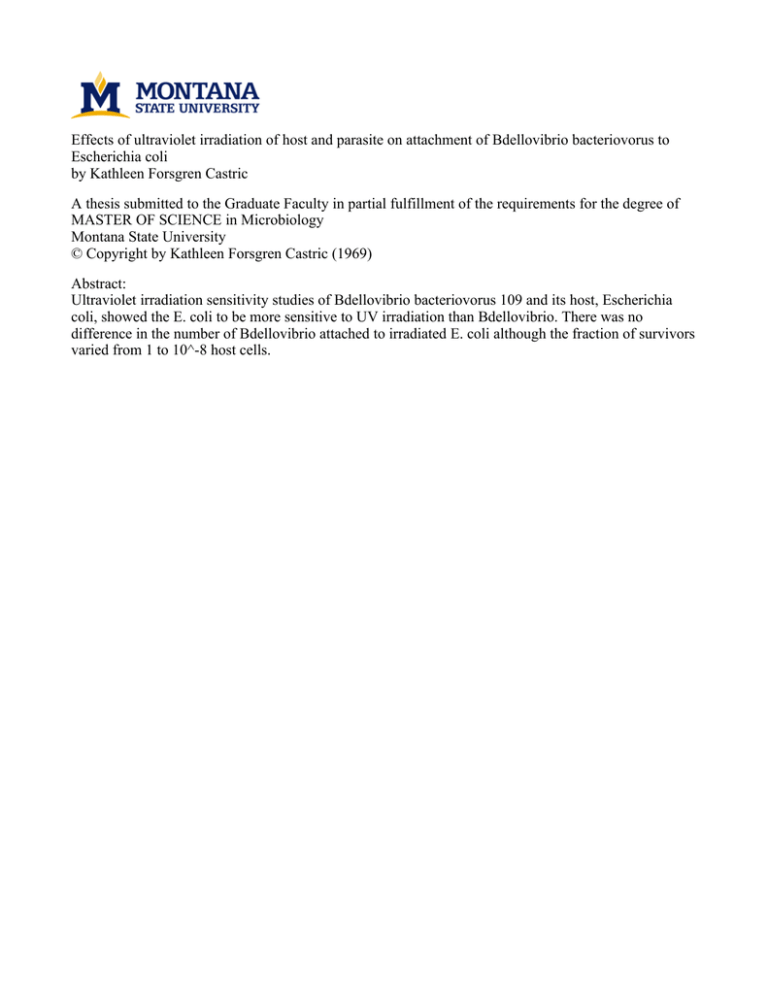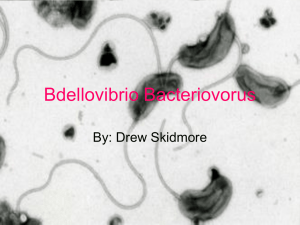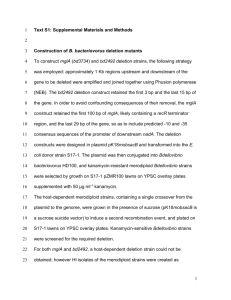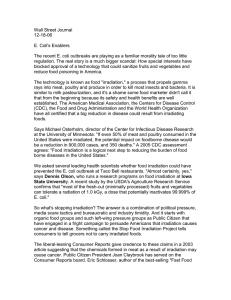Document 13491028
advertisement

Effects of ultraviolet irradiation of host and parasite on attachment of Bdellovibrio bacteriovorus to Escherichia coli by Kathleen Forsgren Castric A thesis submitted to the Graduate Faculty in partial fulfillment of the requirements for the degree of MASTER OF SCIENCE in Microbiology Montana State University © Copyright by Kathleen Forsgren Castric (1969) Abstract: Ultraviolet irradiation sensitivity studies of Bdellovibrio bacteriovorus 109 and its host, Escherichia coli, showed the E. coli to be more sensitive to UV irradiation than Bdellovibrio. There was no difference in the number of Bdellovibrio attached to irradiated E. coli although the fraction of survivors varied from 1 to 10^-8 host cells. In presenting this thesis in partial fulfillment of the require­ ments for .an .advanced degree at Montana State University, the Library shall make it freely available for inspection, I agree that I further agree that permission for extensive copying of this thesis for scholarly purposes .may be granted.by m y major, professor, the Director of Libraries, or, in his absence, by It is understood that any copying or publica­ tion of this thesis for financial gain shall not be allowed without my written permission. Signatur EFFECTS OF ULTRAVIOLET IRRADIATION OF HOST'AND -PARASITE ON • ATTACHMENT"OF--BDELLOVIBRTO BAOTERIOVORDS"TO ESCHERICHIA COLI by KATHLEEN-FORSGREN GASTRIC ■, *5 / A thesis su b m i t t e d ;to the" Graduate Faculty in-partial fulfillment.of the requirements f o r :the degree of MASTER OF SCIENCE' in . Microbiology -■ Appro v e d : H e a d , Maj or ^Department Chairman,.Examining Committee Dean,/College of G r a ^ 6 t e Studies MONTANA STATE -,UNIVERSITY Bozeman, Montana Decembdp., 1969 iii ACKNOWLEDGEMENT The author wishes to ..express her gratitude to Dr- EvD. Skaar for his assistance, guidance and encouragement throughout graduate training.- Sin­ cere thanks are also expressed to Dr. F.S., Newman for giving,so generously of his time and,advice;"and to- other members of the staff at Montana State University who have offered assistance and'encouragement. Iv ■ TABLE OF CONTENTS Page INTRODUCTION . . . . . . . . . . . . . . . . . . . . . MATERIALS AND METHODS . . . . . . ............. ............. . . . . . ........... RESULTS, ......................... I 4 7 DISCUSSION . . '.......... ................ . ... . . . . . . . . . . . 15 SUMMARY 17 .................... LITERATURE;CITED ......... . . . . . . . . . . . . . . . . . . . . . . 18 V LIST OF TABLES- Page TABLE' TABLE I. Survival II. Survival.of TABLE III. TABLE■ of EL cbli Survival B d . 109 of B d . 109 following UV irradiation following UV irradiation . . . . . . . . 8 .10 adsorbed to UV "killed E.;c o l i ............13 IV. Survival of irradiated B d . 109 attached to irradiated E. coli . . . ........................... .. 14 VX LIST ,OF FIGURES, Page Figure I. Survival of _E. coli following UV irradiation . . ■........... Figure 2. Survival of B d . 109 following UV irradiation ■\ 9 11 vii ABSTRACT Ultraviolet irradiation sensitivity studies o f 'Bdellovibrio bacteriovorus 109 arid its host, Escherichia coli, showed.the.Bh "noli,to be more sensitive to U V 'irradiation: thari-.'.'Bdelldvibrio. There was no differ erice in. the number of Bdellovibrio attached to Irradiated _E. coli although the frac tion of survivors varied from I to 10“ ® host cells. INTRODUCTION Bdellovibrio bacteriovorus is the first-bacterium to be isolated that parasitizes another bacterium and replicates within the h o s t . Its dis­ covery by Stolp and Petzold (1962) came about because i f causes a.lytic reaction that is superficially similar to that caused by bacteriophage. However, Bdellovibrio plaques: do not appear* until two to f o u r .days after plating, whereas phage plaques appear within" one' dayv Bdellovibrio was first shown.to enter and replicate within its host.by Scherff at a]L (1966).• The. organism itself is a small, comma-shaped; gram- negative bacterium, with a thick polar flagellum, sheathed its entire length. The dimensions of the.organism are approximately 1.0 x 0.3 microns, varying with age and, culture conditions. : Some species of Bdellovibrio have an extensive host range while others have a limited host range. For.example, Bdellovibfio bacteriovorus strain W was found by Burger _et_ al_ (1968) to attack' Streptococcus faecalis and Lactobacillus .plantarum, as -well as several Ehterobacteriaceae. Stolp and. Starr (1963) listed 12 different .bacterial strains, including Escherichia, Pseudomonas, Rhpdospirillum,- Erwinia, and-Aerobacter species, which would serve as host for Bdellovibrio'bacteriovorus used in these experiments.. A limited host range was found for Bdellovibrio-bacteriovorus 128 lytic -on, Aerobacter cloacae,only (Stolp and Starr, 1963). Bdellovibrio bacteriovorus seems to b e 'widespread, in nature, having been isolated from localities in North, Central, and South America., and in Africa, India, Israel* a n d •Jap a n .. It hag been isolated from soil, sewage, and sea water, Seidler and Starr (1969) propose five terms to describe.the 2 Bdellovibrio life cycle: Attachment, penetration, elongation, fragmenta­ tion, and burst. The initial step in attachment is a violent collision of the parasite with its host. Stolp a n d •Petzold (1962) and Stolp and Starr (1963) suggest that the collision damaged the host cell.wall, and that this is important in attachment. In support of this suggestion, Varon and Shilo that agents which inhibit motility also inhibit attachment. sion, the parasite begins to rotate rapidly. (1968) found After colli­ This movement could act as a drill (Stolp, 1968) or an arm-in-socket type action. The latter type. motion would weaken the host, cell.wall, amking it susceptible to osmotic forces (Starr and Baigent, 1966). Burnham _et al (1968) showed the first change in the host,cell is a bulging of the cell wall and membrane at the point of attachment.- Next, a pore is formed in the cell wall and the para­ site enters the host (Scherff et al, 1966; Starr and Baigent, 1966; Burger et a l , 1968). Varon and Shilo (1968) showed that penetration of.the parasite was inhibited by streptomycin, puromycin, and chloramphenicoli antibiotics had any effect on attachment. attachment nor penetration. None of these Penicillin affected neither These results indicate that mechanical forces alone are not sufficient to permit parasite penetration of the host. Elongation begins when the parasite has entered the host and starts to grow into a long spiral or C-shaped structure. 'This growth continues until the Bdellovibrio completely fills the host' cell' (Scherff et al, 1966; Starr and B a i gent, 1966; Seidler and Starr, 1968)» During fragmentation, the spiral-shaped structure breaks into daughter 3 cells and with the burst they are liberated from the h o s t , Scherff at al (1966), using the host !Pseudomonas fluorescens, reported that the life cycle from attachment to burst could be completed in one hour, with an average of 8-12'B y bacteriovorus produced in one h o s t , Starr and Baigent (1966), working with different strains of Bdellovibrio, report­ ed that the time for the.life cycle can.vary from five.to six hours or longer, depending on the length of time the parasite has been without a host. Seidler and Starr (1969) reported an average of.5.7 B d . 109 cells produced from a singly infected host. The purpose of the following work was: To compare the ultraviolet sensitivities o f ’Bdeliovibrio bacteriovorus 109 and its host, _E. coll B, and to determine whether irradiation of. the.host cells affected their ability to support the attachment of Bdellovibrio. MATERIALS AND METHODS A. Bacterial Strains The Bdellovibrio bacteriovorus culture, B d . 10 9 j was obtained from M. P. Starr; University of California at D a v i s . The host,. _E; coli B, strain.TaM B S R , was from the stock cultures of P. D . 'Skaar, Mo n t a n a .State University. B. Media Yeast Peptone Broth,(YPB), composed"of 0.3 percent yeast extract and =06 percent peptone, was used to grow IS. c o l i . It was also used in the preparation of overlay (0.6 percent agar) and the agar.base (1.5 percent) for plaque assay. rio.. Dilute Nutrient Broth (DNB) was used to grow Bdellovib- It was composed of one volume Nutrient Broth plus nine volumes of. distilled water containing 0.2 g/liter of C a (NOg) and 0.01 g/liter of Mn S 0 4 . The buffer used in the irradiating procedures.was composed of 6 g. NAgHPO^, 3 g. KHgPO^ in one liter of distilled water. C. Cultivation The Eh coli broth cultures.were.incubated oh a shaker at.room tempera­ ture. •(approximately 22 C) for 18-20 hours'.'' ' The EL coli was stored on nutrient agar slants in screw cap tubes or in YPB-at 4.C . The liquid cul­ tures of Bdellovibrio were inoculated;by adding 5 ml (5 x IO^ cells) o f a 20 hour, culture of EL coli to 2 ml' (2 x IO^LcelTs).' of Bdellovibrio in 20 ml of D N B . The Bd. 109 cells were taken from the top" layer of stored plates which had been eluted by adding 10 ml of YPB and"letting the plates stand for one hour. The broth cultures were incubated at room temperature (approximately 22 C) on the shaker for 18-20 hours. Plaque assays were 5 carried out by the method used for phage (Stolp and Starr, 1963). melted top agar was added I ml YPB containing’IO^ of ,a Bdellovibrio suspension. To the coli per ml and 0.1 ml The plates were incubated at 35 C for three days before counting the plaques.. The Bdellovibrio were stored by placing a plate showing semi-confluent or confluent lysis at 4 C; transfers were made once a.month. D. Irradiation Procedures For the irradiation of the host, an 18-20 hour culture of _E. coli.was centrifuged for ten minutes at low speed. pended in 10 ml of buffer.. dard petri dish. The bacteria were then resus­ The suspension was mixed and placed in a stan­ A General Electric germicidal ultraviolet lamp was used to irradiate the sample. The distance from the center of the irradiation source to the dish was 44.5 c m . . A rotary shaker was used to agitate the, sample throughout.the period of irradiation. All work was done under red light, a n d ‘the plates were incubated in the dark at 37 C. The irradiation of Bd. 109 followed the procedure given for its host with the following modifications: For the irradiation of Bd. 109, an 18-20 hour culture was centrifuged at low speed for ten minutes. Five,ml of,the supernatant con­ taining Bdellovibrio were then added to.5 ml of buffer, the suspension mixed, and placed in a petri dish. described above. Irradiation was then carried out as The plaque assay plates were incubated for three days be­ fore counting. In performing the ■experiments' using non-ifradiated B d . 109 and irradi­ ated E. coli, the E.- coli were treated in the manner described previously. 6 Samples o f .1.0 ml containing IO^ host cells' were taken at different time intervals, and'mixed with 0.1 ml containing'10^.:Bdellovibrio„ The samples wer.e then in c u b a t e d '30 minutes in the dark to allow for attachment. were then filtered, through a 0.65 micron pore size Milllpore filter,. filtrate was diluted, and plated u p o n ‘non-irrad'iated El. coli host. They The The filters then were p l a c e d .in 5 ml of distilled water a n d .left for 30 or 60 minutes. The distilled water with the filters.was agitated, samples of the eluate were taken, and: also plated upon non-irradiated E/ c o l i . The purpose of this last step was to recover the Bd. 109 which had attached to _E. coli, and could no longer pass through the filter. For the experiments using both irradiated E;." coli and' Bdellovibrio, the host and parasite were irradiated.separately, samples were ta^en at given time intervals, and t h e -Eh coli.and Bdellovibrio mixed for each time interval. They were then incubated for 30. minutes to allow for attachment. The samples were filtered, the filtrate diluted, and plated upon a nonirradiated host. The filters then were placed in 5 ml of distilled,water and left for 30 or 60 minutes. The distilled water with the filters, was agitated, samples were taken, and also plated upon non-irradiated Eh c o l i . RESULTS A. The Ultraviolet Sensitivities of E. Coli and -B.: bacteriovorus Five experiments were performed to test the ultraviolet sensitivity of the E. coii host. The results a r e 'g i v e n ■in Table I and Figure I. The change in the slope of the curve-which seems to occur at about IO-^ sur­ vival may be due to the existence of a subpopulation of more resistantmutants . Five experiments also were performed-to -test ..the ultraviolet sensi­ tivity o f .Bdellovibrlo bacteriovorus. and, Figure 2. The results are given in Table II The survival curve appears to be linear to 10“ ^ survivors. As can be seen by a comparison of the _B; bacteriovorus survival curve with that of _E. coli (superimposed on Figtire 2), the ultraviolet sensi­ tivity of Bh coii is greater than that of Bdellovibrio. This is probably due, in part at least, to the larger target size. B. The Attachment," of: .Bv bacteriovorus ■to Irradiated _E. coii Three experiments were.performed in an attempt- to assess the ability of irradiated JE. c o i i .to support the attachment of Bdellovibrio. Eh coll was irradiated-for periods of O to 60 seconds, and its capacity as host checked at intervals. The Bdellovibrio cells -were allowed to attach for thirty minutes, and then the host-parasite suspension was filtered in order to separate the un­ attached B d . 109 which:would pass'through the filter. The host, cells with the attached. '.Bdellovlbrio were, then -eluted.and ,plated upon non-irradiated E. coii. When the'filtrate.:was. assayed, ,i f was found■that ■the number of Bdellovibrio in- the. filtrate, remained.-constant with time. • TABLE I Survival of E. coll following UV irradiation Fraction of cells surviving UV irradiation Experiment Number ______ I_____________ 2______________ 3_______ 6 x IO8 C1-) 7 x IO8 1.3 x IO9 _____ 4______________ 5__________ Average 5 x IO8 2 x IO8 7.16 x IO-2 4.34 x 10-3 2.32 x 10"4 7.19 x ICT2 9.28 x 10-4 8.45 x IO"3 4.54 x IO-3 2.32 x ICT4 3.12 x IO"6 6.68 x 10-7 6.6 x IO8 3.82 x IO-5 1.0 x IO-5 6.5 x IO-6 4.31 x IO-9 1.44 x 10“5 3.36 x 10-7 1.15 x 10-8 (I) Viable cell count at time 0 2.0 x IO"9 1.0 x IOT8 - 7.80 x IO"9 Figure I Survival of JE.'coli following U V irradiation. The curve through the x's represents the average of the fraction r■ > ‘ K surviving* for each time interval.)- The.dots represent the results of each individual experiment. '# # Fraction of E . coll surviving 9 0 10 20 30 40 Time in Figure Survival of IS. c o l l 50 60 70 seconds I following UV irradiation 80 TABLE TI Survival of B d . 109 following UV irradiation Fraction of cells surviving UV irradiation Experiment Number I 2 3 2.0 x 105(1) 3.5 x IO6 1.3 x IO"2 7.7 x IO"3 2.92 x IO"2 3.0 x IO"3 8.5 x IO"4 1.33 1.5 x IO7 x IO"3 2.0 x 10~6 1.0 x IO"5 2.0 x 10~7 (I) Viable plaque count at time 0 4 5 1.2 x IO7 4.8 x IO7 1.6 1.25 x 10~3 2.3 6.5 x IO"2 Average x IO7 x IO"2 8.75 x 10"4 1.33 8.34 1.46 x IO"5 3.34 8.3 2.56 x 10~6 x IO"5 8.3 x IO"8 x 10~4 1.08 x 10"4 x IO"8 x IO"5 Figure 2 Survival of B d . 109 following- U V irradiation. The dashed line through the circles represents the average of the fraction of B d .'109'surviving'for each time interval. The dots represent the results of each individual experiment, : -; and the straight line represents the average number of ■V Eh- coli survivors. I ■ 11 Fraction of _Bd_. 1 09 surviving --0 Time in Figure Survival of jkl. 109 seconds 2 following UV irradiation B d .109 E . coI i 12 The number of plaque forming'units' retained by the filter (Table III) did not decrease markedly even after exposure of the host.to irradiation which should have killed all but about 2^2 x IO^ h o s t .cells. Therefore, it is safe to conclude that t h e ' Bdellovibrio had'-attached to the irradiated host cellso Penetration and growth were not measured in these experiments ■ but it is probable that they did occur. In support of this argument Varon and Shilo (1968) demonstrated that within thirty minutes 90 percent of the attached Bdellovibrio had penetrated their host cells. Therefore, in I order to form plaques the’ Bdellovibrio would h a v e 1to be using the irradi­ ated cells as hosts. Otherwise they would have to leave the irradiated host and enter a non-irradiated;h o s t ,in order to form p laques. Two trials were made in an effort to see what the-results of plating irradiated Bd. 109 o n 1irradiated E,. c o l i .would be'. Since Bci, 109 will grow on. irradiated J3. c o l i . (Stolp, 1968), it would be expected that the survival curve would.drop as did that of the irradiated;B d . 109 on non-irradiated E. c o l i . This was found,to happen. For this experiment, Bdellovibrio and Ev coli.were irradiated, attachment allowed to proceed; and the cells were then filtered.- A reduction in the number of cells was found both in the, non-attached cells which passed through the filter and in the.attached Bdellovibrio which remained on the filter.. - No-1Viable Bdellovibrio could be recovered from the filter after 15 seconds or from the filtrate after 30 seconds. At 30 seconds there was an average of .11 percent survivors so the small number of viable cells remaining were probably lost in the fil­ tration and elution process. ments . Table IV gives the results of the two experi­ TABLE III Survival of Bd. 109 absorbed to UV killed E.x Coli Plaque Counts of B d . 109 Experiment Number Period of exposure of E. coll to UV- ____________ I o 1.7 ______________________ I_________________ x IO5 3 1.1 x IO2 CO rO 15 5.0 x IO4 g % 30 7.2 x IO5 45 4.0 x IO4 7.9 x IO3 1.0 x IO3 60 2.0 x IO5 7.0 x IO3 3.0 x IO3 1.0 x IO2 1.1 x IO4 1.0 x IO5 CO I-H TABLE IV Survival of irradiated Bd. 109 attached to irradiated jE. coli Plaque Counts of B d . 109 Unattached Experiment Number 2 . . . . 0 m O tH X CT\ CO Period of exposure to UV in seconds I Attached Experiment Number 7 x IO4 15 6.7 x IO3 8.1 x IO3 30 9 60 I 1.4 x IO4 52 . 2 3 x IO4 1.3 x IO3 H DISCUSSION The ultraviolet sensitivities": of Bdellovibrio .'.b'acteriovorus 109 and its host, Escherichia coli, were compared. The Eh coli was,more sensitive to irradiation than the Bdellovibrioh: T h e '.E. coli'probably has a larger target size than B d . 109 which would account for' its greater sensitivity. Attachment of BdellOvibrio to Eh coli was not changed regardless of the numbers of survivors o f 'Eh c oli. Varon and'Shilo (1968) demonstrated that Eh coli hosts which had been irradiated w o u l d .allow the attachment of B d . 109. Stolp (1968) has said that Bdellovibrio will grow on host cells which have been irradiated. However, he did not indicate which strain of Bdellovibrio was used,- nor did he'publish any supporting data. In view of. Stolp's work; there is the possibility that the plaques formed in these experiments were due t o .growth on irradiated Bdelloyibrio.. . The attachment sites for B. bacteriovorus are.not in any way damaged by ultraviolet light, as they are by.heat, chloroform, or toluene (Stolp, 1968). Shilo and Bruff (1965) isolated a strain of' Bdellovibrio that retained its parasitic capabilities when grown, on host-free media. Seidler and Starr (1969) were able to g r o w 'Bdellovibrio w h e n .the host and parasite were suspended in a buffer system. This argues that one.of the main contribu­ tions of the.host is an.essential nutrient, or nutrients, - It would also explain.the ability of .a UV killed cell with'its receptor sites intact to support the growth.. OfrBdellovibrio. The survival curve obtained when b o t h :irradiated E. c o l i ,and Bdello. . . - ' P' vibrio are used.is predictable, since Bd.'109'can.attach and,presumably grow o n .E / c o l i .. The ■curve,:.as expected',"'follows the survival curve of 16 irradiated B d . 109 on non-irradiated E. coli SUMMARY' Ultraviolet irradiation sensitivity studies of Bdellovibrio bacteriovorus 109 and its host, Escherichia coli, showed the _E. coli.to be more sensitive to UV irradiation than Bdellovibrio. There was no difference in. the number of Bdellovibrio attached to irradiated _E. coli although the frac­ tion of survivors varied from I.to IO-^ host cells. LITERATURE CITED • Burger, A., G. Drews and Rita L a dwig. 1968. Wirtskreis und Infections-r cyclus e i n e s .neu isolierten Bdellovibrio bacteriovorus-Stammes. Arch. Mi k r o b i o l . _61: 261-279. ■ Burnham, J . C . , T. Hasimoto, ,and'S.Fi Conti. 1968. Electron Microscopic Observations on the Penetration of Bdellovibrio bacteriovorus into Gram-negative Bacterial H o s t s . J . Bacteiriol. _96: 1366-1381. Scherff, R.H., J.E. D e V a y , and T. Carroll. 1966. Ultrastructure of Host Parasite Relationships Involving Reproduction of Bdellovibrio bacteriovorus -in Host Bacteria. Phytopathology., 56^: 627-632. Seidler, R . J . , and M.P. Starr, 1969. Factors Affecting the Intracellular Parasitic Grow t h ,of Bdellovibrio bacteriovorus Developing Within Escherichia c o l i . J. Bacteriol. _97: 912-923. Shilo, M. 1966. Predatory Bacteria. . Sci. J . 2j 33-37. Shilo, M., and Barbara Bruff. 1965. Lysis of Gram-Negative■Bacteria-by■ Host-Independent Ectoparasitic Bdellbvibrio bacteriovorus Isolates. J. Gen. Microbiol. 40_: 317-328. Starr, M.P., and N. Baigent. 1966. Parasitic Interaction o f ■Bdellovibrio bacteriovorus with Other Bacteria. J; Bacterial. 91_: 2006-2017. Stolp, H., and H i Petzold. 1962. Untersuchungen uber einen Obligat Parasitischen Mikroorganism mit Lytischer Aktivitat fur PseudomasBakterien. Phytopathol. Z . 4-5: 364-390. Stolp, H., and M.P. Starr. . 1963. Bdellovibrio bacteriovorus gen, et. sp. n . , A Predatory Ectoparasitic, and Bacteriolytic Microorganism.■ Antonie van Leeuwenhoek.J . Microbiol, Serol. 29_: 217-248. Stolp, H. 1968. Bdellovibrio bacteriovorus-ein rauberischer Bakterienparasit. Naturwissenschaf ten. 55_: 57-63. V a r o n , M., and M. Shilo. , 1968. Interaction,of Bdellovibrio bacteriovorus and Host Bacteria. J. Bacteriol.. 95: 744-753., MONTANA STATE UNIVERSITY LTRPARTM 3 1762 100 3218 O Gastric, Kathleen F. Effects of ultraviolet irradiation of host and parasite on... C o io . D-""





